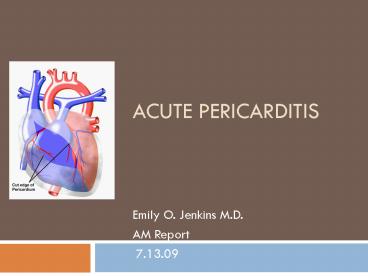ACUTE PERICARDITIS - PowerPoint PPT Presentation
1 / 14
Title:
ACUTE PERICARDITIS
Description:
ACUTE PERICARDITIS Emily O. Jenkins M.D ... tuberculous, purulent) Constrictive pericarditis occurs in about 1% of patients 15-30% of patients not treated with ... – PowerPoint PPT presentation
Number of Views:445
Avg rating:3.0/5.0
Title: ACUTE PERICARDITIS
1
ACUTE PERICARDITIS
- Emily O. Jenkins M.D.
- AM Report
- 7.13.09
2
Incidence
- Exact incidence and prevalence are unknown
- Diagnosed in 0.1 of hospitalized patients and 5
of patients admitted for non-acute MI chest pain - Observational study 27.7 cases/100,000
population/year
3
Etiology Can be Tricky. . .
- Standard diagnostic evaluations are oftentimes
relatively low yield - One series elucidated a cause in only 16 of
patients - Leading possibilities
- Neoplasia
- Tuberculosis
- Non-tuberculous infection
- Rheumatic disease
4
(No Transcript)
5
Initial clinical and echocardiographic evaluation
of patients with suspected acute pericarditis
6
Diagnostic Criteria
- Chest pain anterior chest, sudden onset,
pleuritic may decrease in intensity when leans
forward, may radiate to one or both trapezius
ridges - Pericardial friction rub most specific, heard
best at LSB - EKG changes new widespread ST elevation or PR
depression - Pericardial effusion absence of does not exclude
diagnosis of pericarditis - Supporting signs/symptoms
- Elevated ESR, CRP
- Fever
- leukocytosis
7
EKG
Electrocardiogram in acute pericarditis showing
diffuse upsloping ST segment elevations seen best
here in leads II, III, aVF, and V2 to V6. There
is also subtle PR segment deviation (positive in
aVR, negative in most other leads). ST segment
elevation is due to a ventricular current of
injury associated with epicardial inflammation
similarly, the PR segment changes are due to an
atrial current of injury which, in pericarditis,
typically displaces the PR segment upward in lead
aVR and downward in most other leads.
8
Pericardial Effusion
Cardiomegaly due to a massive pericardial
effusion. At least 200 mL of pericardial fluid
must accumulate before the cardiac silhouette
enlarges.
9
Tests
- EKG
- CXR
- PPD
- ANA
- HIV
- Blood cultures
- Urgent echocardiogram if evidence of pericardial
effusion - Not necessary
- Viral studies b/c yield is low and management is
not altered
10
Treatment
- NSAIDs PPI
- Aspirin (2-5 g/day)
- Ibuprofen (300-800 mg q6-8H)
- Ketorolac
- Theoretical concern that anti-platelet agents
promote development of hemorrhagic pericardial
effusion has not been substantiated - Colchicine (0.5-1 mg/day) may prevent
recurrence - Glucocorticoids (prednisone 1 mg/kg/day) ?
increased rate of complications. Should be
restricted to - Acute pericarditis due to connective tissue
disease - Autoreactive (immune-mediated) pericarditis
- Uremic pericarditis
NSAID of choice unless associated with acute MI,
where all non-ASA NSAIDs should be avoided
11
Prognosis for acute idiopathic pericarditis
- Good long-term prognosis
- Cardiac tamponade is rare, but up to 70 in cases
with specific etiologies (eg. Neoplastic,
tuberculous, purulent) - Constrictive pericarditis occurs in about 1 of
patients - 15-30 of patients not treated with colchicine
develop either recurrent or incessant disease
12
Recurrent Pericarditis
- Exact recurrence rate unknown
- Most cases considered to be autoimmune
- Risk Factors
- Lack of response to aspirin or other NSAID
- Glucocorticoid therapy
- Inappropriate pericardiotomy
- Creation of a pericardial window
- For some patients, symptoms can only be
controlled with steroidal therapy
13
Autoreactive Pericarditis diagnostic criteria
- Pericardial fluid revealing gt5000/mm3 mononuclear
cells or antisarcolemmal antibodies - Inflammation in epicardial/endomyocardial
biopsies by gt14 cells/mm2 - Exclusion of active viral infection both in
pericardial effusion and endocardial/epicardial
biopsies - Exclusion of tuberculosis, borrelia burgdorferi,
chlamydia pneumoniae and other bacterial
infection - Absence of neoplastic infiltration in effusion
and biopsy samples - Exclusion of systemic, metabolic disorders and
uremia
14
Treatment
- Aspirin
- NSAIDs
- Colchicine can reduce or eliminate need for
glucocorticoids - Glucocorticoids should be avoided unless
required to treat patients who fail NSAID and
colchicine therapy - Many believe that prednisone may perpetuate
recurrences - Intrapericardial glucocorticoid therapy sx
improvement and prevention of recurrence in 90
of patients at 3 months and 84 at one year - Other immunosuppression
- Azothoprine (75-100 mg/day)
- Cyclophosphamide
- Mycophenolate anecdotal evidence only
- Methotrexate limited data
- IVIG limited data
- Pericardiectomy To avoid poor wound healing,
recommended to be off prednisone for one year.
Reserved for the following cases - If gt1 recurrence is accompanied by tamponade
- If recurrence is principally manifested by
persistent pain despite an intensive medical
trial and evidence of serious glucocorticoid
toxicity































